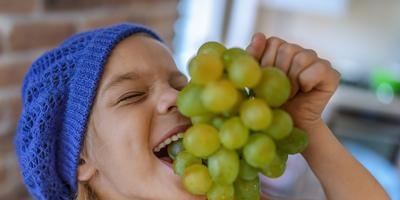|
 Grapes and humans have long been at odds. The first tried to reach up to the sky. The second stopped this desire, did not allow to rise too high. I cut off the shoots that rush to the sun. Both had good reasons for this discrepancy. Grapes and humans have long been at odds. The first tried to reach up to the sky. The second stopped this desire, did not allow to rise too high. I cut off the shoots that rush to the sun. Both had good reasons for this discrepancy.
The grape origin is forest liana. Like other lianas, it is adapted to climb other people's trunks in order to bring the crown out to the light.
When the gloomy era of slavery came and the vast latifundia appeared (large landowners' landholdings that arose in ancient Rome in the 2nd century BC), the troubles with large trees were considered unnecessary. Why wait for a tree to grow when there is free labor? Since then, it was customary to disfigure the vine. The custom has survived to this day. And instead of half a ton of berries put to her, the mutilated bush gives four to five kilograms - a hundred times less.
Observing objectivity, we note that in some places the vine still lives freely, in the old fashioned way, as it pleases. I mean the garlands that decorate the walls of houses in Odessa and other southern cities. Nobody cuts the vine. But nevertheless, it seemed to the man more profitable to harvest from low bushes, and not to climb for bunches in the skies.
 However, there was a time when people found it possible to combine their own and grape interests. At the same time, both sides won. You can name a more or less exact date of the golden age for home grapes - the times of Ancient Rome. That early Rome, when there was still no slavery and when everyone worked on their own piece of land. Since the shreds were small in size, there was nowhere to cultivate vast vineyards. Then the idea of high-altitude viticulture arose. However, there was a time when people found it possible to combine their own and grape interests. At the same time, both sides won. You can name a more or less exact date of the golden age for home grapes - the times of Ancient Rome. That early Rome, when there was still no slavery and when everyone worked on their own piece of land. Since the shreds were small in size, there was nowhere to cultivate vast vineyards. Then the idea of high-altitude viticulture arose.
Before planting plantations, a land-poor Roman planted support trees. The trees grew for a long time, but in that century there was nowhere to rush. The trees stretched higher, and with them the vines. Of course, such high-rise structures had to be watered fairly, but the return was downright fantastic: 500 kilograms from one bush! From one vine!
And the mighty liana gives the owners an excellent harvest in accordance with its biological characteristics. An expert on wall vineyards from Odessa V. Zotov calculated that each bush gives at least 50 kilograms, and sometimes more.
It is these very kilograms that have been embarrassing wall growers since the beginning of the last century. To break the ancient Roman record! The Englishman A. Dawes started the doubts. He painted his house and covered one of the walls with black paint. Another wall was left unpainted. In the fall, I began to harvest and discovered the difference. I took twenty pounds of excellent product from the black wall, but unpainted gave only seven, and the quality is very mediocre. Since then, other fans of wall vineyards have started repainting their homes black. And only the gloomy, unsightly appearance of such dwellings did not turn this method of increasing yields into a mass event.
However, grapevines are not allowed on one wall. When the blue grape Isabella was brought to Abkhazia, they began to let it go straight through the trees, as in old Roman times. And she obediently climbed the branches, lived without any care and concern, hanging purple bunches. However, it is difficult to harvest.
Among the aristocratic European vines with their catchy appearance and the finest flavor nuances of berries, the American relative looks like Cinderella. A second-rate creature. Isabella is from southern Canada.
It was brought in in the middle of the last century, when the parasitic fungus oidium (powdery mildew) appeared in the vineyards. He made them constantly spray the bushes with poisons. There was no trouble with Isabella. She was not sprayed. She is from the homeland of oidium. I got used to it. And does not suffer from illness.
 Soon, Isabella fell in love with the Abkhazians so much that she appeared in every courtyard and almost on every tree. The writer K. Paustovsky was delighted with her: “... All the time I heard the smell of Isabella, which ran close by, then it went far away. He haunted me until I went down to the small vineyard behind the house and saw heavy gray clusters in the shade of the grape leaves, slightly gilded by the sun. They hung from wooden supports and were filled with purple juice ... these grapes, I thought, had the taste of Spain. " Soon, Isabella fell in love with the Abkhazians so much that she appeared in every courtyard and almost on every tree. The writer K. Paustovsky was delighted with her: “... All the time I heard the smell of Isabella, which ran close by, then it went far away. He haunted me until I went down to the small vineyard behind the house and saw heavy gray clusters in the shade of the grape leaves, slightly gilded by the sun. They hung from wooden supports and were filled with purple juice ... these grapes, I thought, had the taste of Spain. "
Experts-winegrowers appreciated Isabella's taste in a completely different way. They responded in a purely professional manner, noted that they were like a fox. They began to say that Isabella had a "fox" taste, and even invented the term "foxiness", But what is meant by "foxiness", historians still cannot find out. What is the "fox" taste? And what does he have to do with the fox?
At the beginning of the century, G. Gogol-Yanovsky, a specialist in his field, tried to compare it with something edible. In his opinion, the "fox" flavor "is somewhat reminiscent of strawberry and many people like it." And the Leningrad professor N. Kichunov even created a classification, dividing humanity in relation to Isabella into three categories. Some are disgusted with her and do not take it in their mouths. Others are indifferent. Still others are crazy about her.
Kichunov included himself in this third group.
However, since the term "foxiness" itself remained unsolved, let us try to assume that Fox-Patrikeevna herself was involved in the case. Moreover, the connection of grapes with a fox is often emphasized even in fiction. Such a delightful product as grapes, of course, could not go unnoticed by a beast. And specifically a fox.
The fabulists have convinced us of this. Even the most ancient classic Aesop noticed this in Greece and wrote the fable "Fox and Grapes". He emphasized the fox's passion for sweet bunches. And the famous Russian fabulist I. Krylov in his fable "The Fox and the Grapes" testified that it is so.
Observing the truth, let us note that neither one nor the other were specialists in biology. Meanwhile, the classic of zoology A. Brehm once warned that fabulists can sometimes exaggerate facts. Referred just to the fox. She was awarded the title in the fables for cunning. In fact, the fox, although cunning, is no more than a wolf or a hare. Therefore, it is worth checking Aesop and Krylov on modern material and listening to what zoologists of the 20th century say. To the credit of the fabulists, it must be said that they did not in the least sin against the truth. Indeed, the fox has an increased love for grapes. In her diet, he occupies about the same place as mice, hares and domestic chickens. This habit has been preserved by Patrikeevna, apparently, from the time when there were no vineyards, and grapes grew only in the forests. Wild. And to this day, the red cheat eats wild. And since it winds along the trunks of trees, then she also has to climb these trunks, if, of course, there are suitable conditions for this: if the branches descend low, forming a kind of ladder.
The fox does not take green grapes, because they are sour. Waiting until it ripens completely. And most of all he loves raisins that dry on bushes. It is said that a Swedish merchant had a tame fox, which, for lack of fresh grapes, he fed with raisins. She preferred raisins to any other food. She took it modestly and ceremoniously, one berry from her fingers or from her palm.
Perhaps the jackal loves grapes no less than the fox. In the Caucasus, in the Lenkoraysky district, in previous years jackals often entered gardens and devoured clusters that hung too low. When the supply of sweets dried up, they were taken for those that were higher. They jumped up and grabbed juicy berries on the fly. Gardeners began to cut the lower bunches in advance, in order to avoid temptation. However, there were also those who shared with their "smaller brothers", donating part of the harvest to them. And they received some prize for this.The fact is that, like foxes, jackals take only completely ripe, fully ripe berries. Acid ones are not taken. And so the owners could calmly wait until the grapes ripen. Jackals signaled the beginning of the gathering.
Raccoon-gargle loves grapes very much. Unlike other four-legged animals, he does not eat grapes without washing, for which he is nicknamed the striped fish. True, he rinses the bunches in the water when there is nowhere to rush. And if time is precious and you really want something sweet, he eats unwashed.
When mankind tolerated the pilgrimage of tetrapods and birds, it always received some benefit for itself. Even if they were all-devouring goats. The goats are said to have taught people how to grow viticulture. Preserved ancient Egyptian drawings, which depict the harvest of grapes. Egyptians with baskets on their shoulders. Nearby, a goat stands on its hind legs and gnaws grape twigs. Note: the picture is peaceful. Nobody drives the goat. The answer to the Egyptian idyll is extremely simple. People noticed that the eaten bushes give a double harvest the next year. Since thinking about the reason for such beneficial changes, they themselves began to follow the goat method of caring for the vine. Hence the art of pruning grapes arose. According to another version, the first in the matter of pruning was not a goat, but a donkey. Another thing is important: caring for grapes is difficult. It was not without reason that the director of the Nikitsky Botanical Garden in Crimea, N. Gartvis, set the training period for winegrowers at 15–20 years.
 Among other tetrapods, sika deer show increased attention to grapes. In Primorye, they build their diet on this liana all year round. In summer they eat leaves, in winter they eat young twigs, sour like sorrel. Domestic cows completely copy them, but do not know the measures, for which they pay with colic and indigestion. In the forest, other herbs are rejected, grapes are chosen. If the vine had not climbed high, it would have been eaten clean. However, in clearings, where the grapes have to creep through the bushes, sometimes this really happens. Among other tetrapods, sika deer show increased attention to grapes. In Primorye, they build their diet on this liana all year round. In summer they eat leaves, in winter they eat young twigs, sour like sorrel. Domestic cows completely copy them, but do not know the measures, for which they pay with colic and indigestion. In the forest, other herbs are rejected, grapes are chosen. If the vine had not climbed high, it would have been eaten clean. However, in clearings, where the grapes have to creep through the bushes, sometimes this really happens.
On plantations, starlings cause a lot of trouble. They fly in large flocks. Not once or twice. It happens that a fourth of the harvest is harvested. But they are just as zealous in destroying insect pests. However, it is a pity for people to pay the birds their "salary". Before the war, growers built noise barriers. They rattled with rattles, beat in old basins, both young and old. Old sheets of iron were used. Women and children screamed hoarsely. At first, Skvortsov scared the concert, then they got used to it. In Turkey, attitudes towards starlings change twice a year. In July, when the harvest ripens, the Turks, indignant, call the starling "devil's bird". However, in general, the matter is limited to swearing. More drastic measures are not taken. They know that next spring, in May, the starling will work off the "advance" it has received - it will collect and eat all the locusts from the fields.
At one time, bees were suspected of spoiling grapes. Beekeepers claimed that especially the white one gets from them. They advised to uproot white, replace with red. Scientists have checked - it turned out that the bees had nothing to do with it. Other insects drill the berries. The bees only lick the remains of someone else's feast. Since trespassers spoil only white berries, bees hover around them accordingly. In Canada, they even staged an experiment. The berries were smeared with honey, some of them were cut, the other part was left untouched. A lot of bees flew. They collected and took away all the honey. We drank juice only from cut berries.
In general, there seemed to be no big damage to grapes. And the growers enjoyed their plantations, pressed sweet juice, dried raisins. No one expected that there would come a time when in a few years the vineyard will be on the verge of death.
And then no one will be able to say whether at least one grape bush will survive on earth?
A. Smirnov. Tops and roots
Read now
All recipes
|